Citroen BERLINGO FIRST 2011 1.G Manual PDF
Manufacturer: CITROEN, Model Year: 2011, Model line: BERLINGO FIRST, Model: Citroen BERLINGO FIRST 2011 1.GPages: 136, PDF Size: 5.94 MB
Page 71 of 136
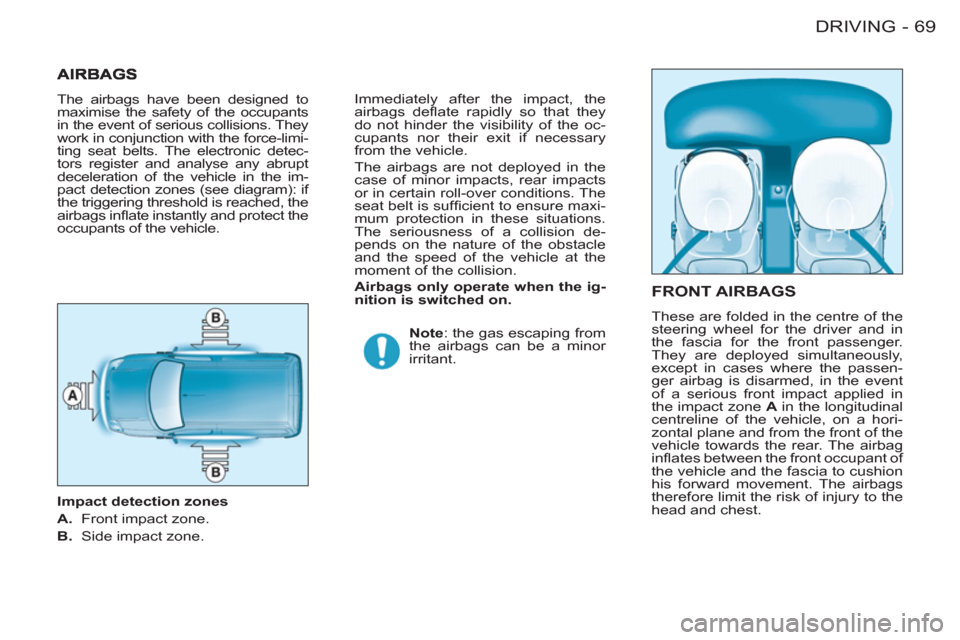
69 DRIVING
-
FRONT AIRBAGS
These are folded in the centre of the
steering wheel for the driver and in
the fascia for the front passenger.
They are deployed simultaneously,
except in cases where the passen-
ger airbag is disarmed, in the event
of a serious front impact applied in
the impact zone A
in the longitudinal
centreline of the vehicle, on a hori-
zontal plane and from the front of the
vehicle towards the rear. The airbag
infl ates between the front occupant of
the vehicle and the fascia to cushion
his forward movement. The airbags
therefore limit the risk of injury to the
head and chest.
The airbags have been designed to
maximise the safety of the occupants
in the event of serious collisions. They
work in conjunction with the force-limi-
ting seat belts. The electronic detec-
tors register and analyse any abrupt
deceleration of the vehicle in the im-
pact detection zones (see diagram): if
the triggering threshold is reached, the
airbags infl ate instantly and protect the
occupants of the vehicle.
Impact detection zones
A.
Front impact zone.
B.
Side impact zone. Immediately after the impact, the
airbags defl ate rapidly so that they
do not hinder the visibility of the oc-
cupants nor their exit if necessary
from the vehicle.
The airbags are not deployed in the
case of minor impacts, rear impacts
or in certain roll-over conditions. The
seat belt is suffi cient to ensure maxi-
mum protection in these situations.
The seriousness of a collision de-
pends on the nature of the obstacle
and the speed of the vehicle at the
moment of the collision.
Airbags only operate when the ig-
nition is switched on.
Note
: the gas escaping from
the airbags can be a minor
irritant.
Page 72 of 136
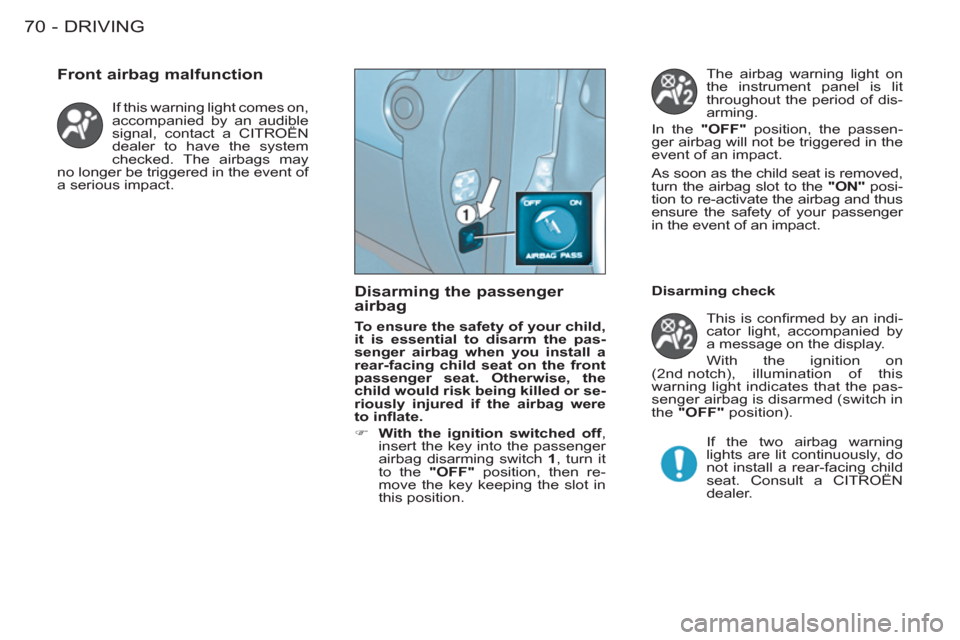
DRIVING70 -
If this warning light comes on,
accompanied by an audible
signal, contact a CITROËN
dealer to have the system
checked. The airbags may
no longer be triggered in the event of
a serious impact.
Front airbag malfunction
Disarming the passenger
airbag
To ensure the safety of your child,
it is essential to disarm the pas-
senger airbag when you install a
rear-facing child seat on the front
passenger seat. Otherwise, the
child would risk being killed or se-
riously injured if the airbag were
to infl ate.
�)
With the ignition switched off
,
insert the key into the passenger
airbag disarming switch 1
, turn it
to the "OFF"
position, then re-
move the key keeping the slot in
this position. The airbag warning light on
the instrument panel is lit
throughout the period of dis-
arming.
In the "OFF"
position, the passen-
ger airbag will not be triggered in the
event of an impact.
As soon as the child seat is removed,
turn the airbag slot to the "ON"
posi-
tion to re-activate the airbag and thus
ensure the safety of your passenger
in the event of an impact.
This is confi rmed by an indi-
cator light, accompanied by
a message on the display.
With the ignition on
(2nd notch), illumination of this
warning light indicates that the pas-
senger airbag is disarmed (switch in
the "OFF"
position).
If the two airbag warning
lights are lit continuously, do
not install a rear-facing child
seat. Consult a CITROËN
dealer.
Disarming check
Page 73 of 136
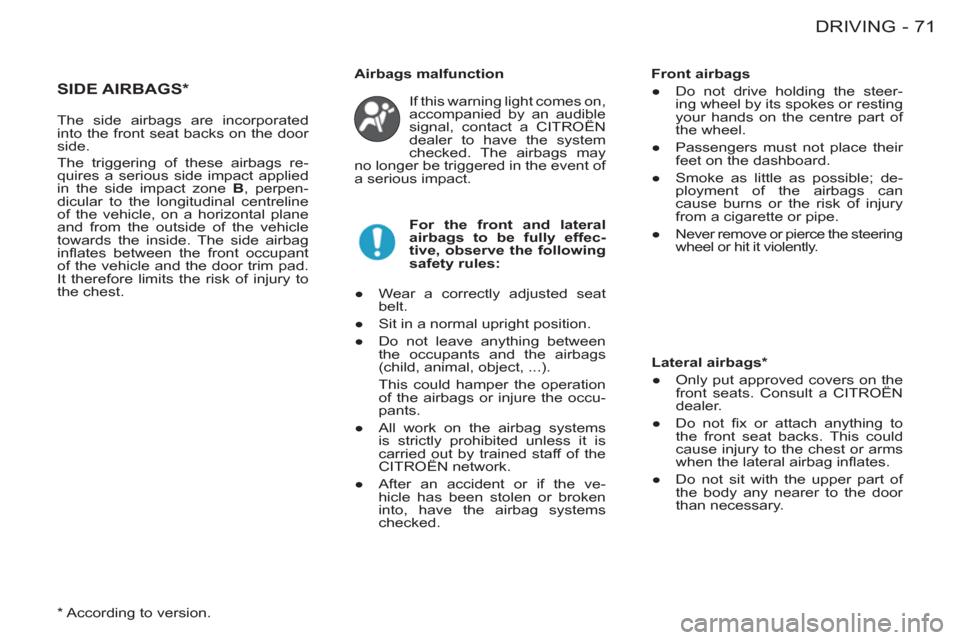
71 DRIVING
-
SIDE AIRBAGS *
If this warning light comes on,
accompanied by an audible
signal, contact a CITROËN
dealer to have the system
checked. The airbags may
no longer be triggered in the event of
a serious impact.
Airbags malfunction
For the front and lateral
airbags to be fully effec-
tive, observe the following
safety rules:
●
Wear a correctly adjusted seat
belt.
●
Sit in a normal upright position.
●
Do not leave anything between
the occupants and the airbags
(child, animal, object, ...).
This could hamper the operation
of the airbags or injure the occu-
pants.
●
All work on the airbag systems
is strictly prohibited unless it is
carried out by trained staff of the
CITROËN network.
●
After an accident or if the ve-
hicle has been stolen or broken
into, have the airbag systems
checked.
Front airbags
●
Do not drive holding the steer-
ing wheel by its spokes or resting
your hands on the centre part of
the wheel.
●
Passengers must not place their
feet on the dashboard.
●
Smoke as little as possible; de-
ployment of the airbags can
cause burns or the risk of injury
from a cigarette or pipe.
●
Never remove or pierce the steering
wheel or hit it violently.
Lateral airbags *
●
Only put approved covers on the
front seats. Consult a CITROËN
dealer.
●
Do not fi x or attach anything to
the front seat backs. This could
cause injury to the chest or arms
when the lateral airbag infl ates.
●
Do not sit with the upper part of
the body any nearer to the door
than necessary.
The side airbags are incorporated
into the front seat backs on the door
side.
The triggering of these airbags re-
quires a serious side impact applied
in the side impact zone B
, perpen-
dicular to the longitudinal centreline
of the vehicle, on a horizontal plane
and from the outside of the vehicle
towards the inside. The side airbag
infl ates between the front occupant
of the vehicle and the door trim pad.
It therefore limits the risk of injury to
the chest.
* According to version.
Page 74 of 136
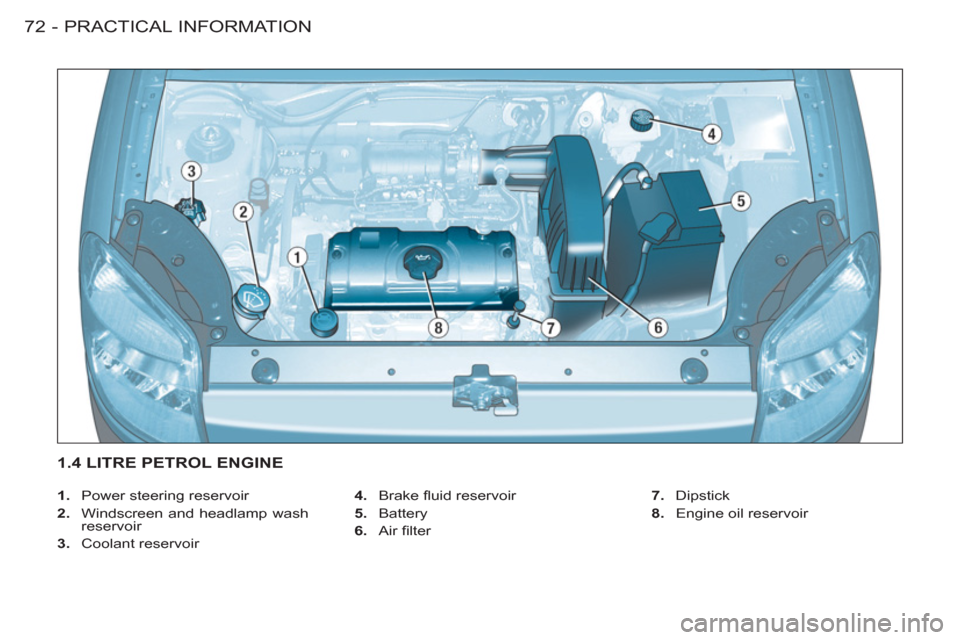
PRACTICAL INFORMATION
72 -
1.
Power steering reservoir
2.
Windscreen and headlamp wash
reservoir
3.
Coolant reservoir
4.
Brake fl uid reservoir
5.
Battery
6.
Air fi lter
7.
Dipstick
8.
Engine oil reservoir
1.4 LITRE PETROL ENGINE
Page 75 of 136
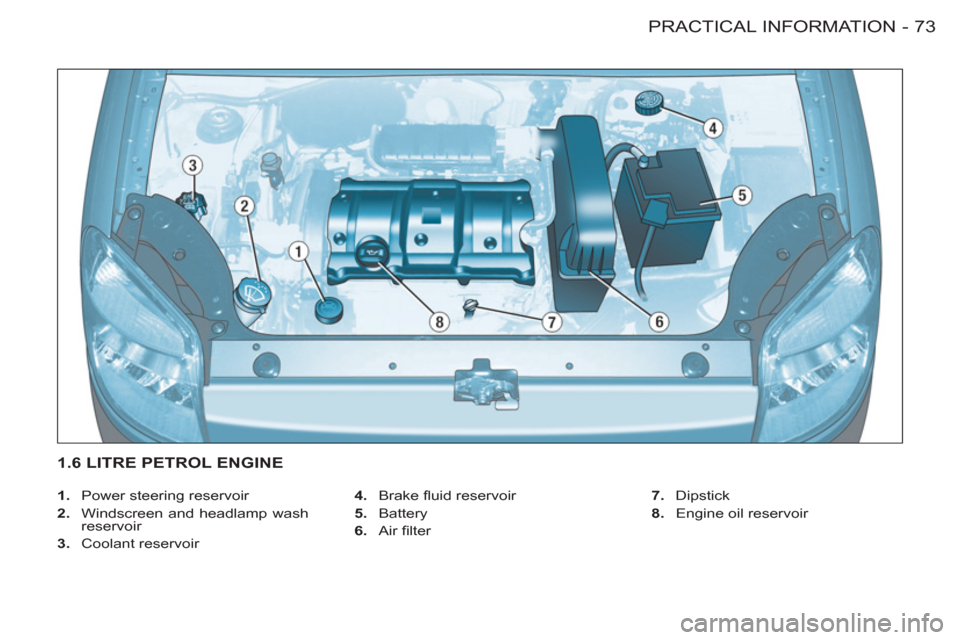
73 PRACTICAL INFORMATION
-
1.
Power steering reservoir
2.
Windscreen and headlamp wash
reservoir
3.
Coolant reservoir
4.
Brake fl uid reservoir
5.
Battery
6.
Air fi lter
7.
Dipstick
8.
Engine oil reservoir
1.6 LITRE PETROL ENGINE
Page 76 of 136
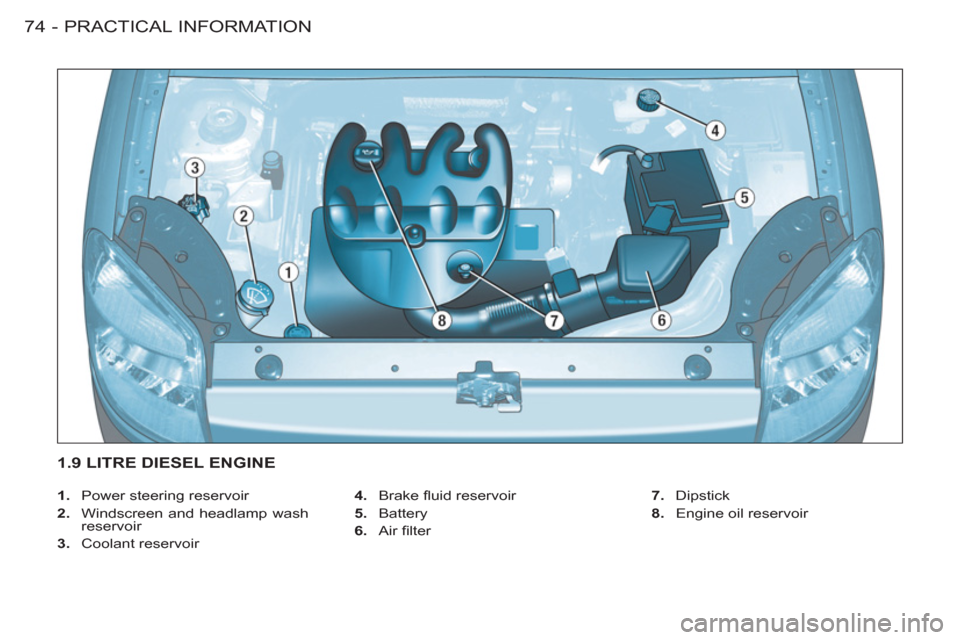
PRACTICAL INFORMATION
74 -
1.
Power steering reservoir
2.
Windscreen and headlamp wash
reservoir
3.
Coolant reservoir
4.
Brake fl uid reservoir
5.
Battery
6.
Air fi lter
7.
Dipstick
8.
Engine oil reservoir
1.9 LITRE DIESEL ENGINE
Page 77 of 136
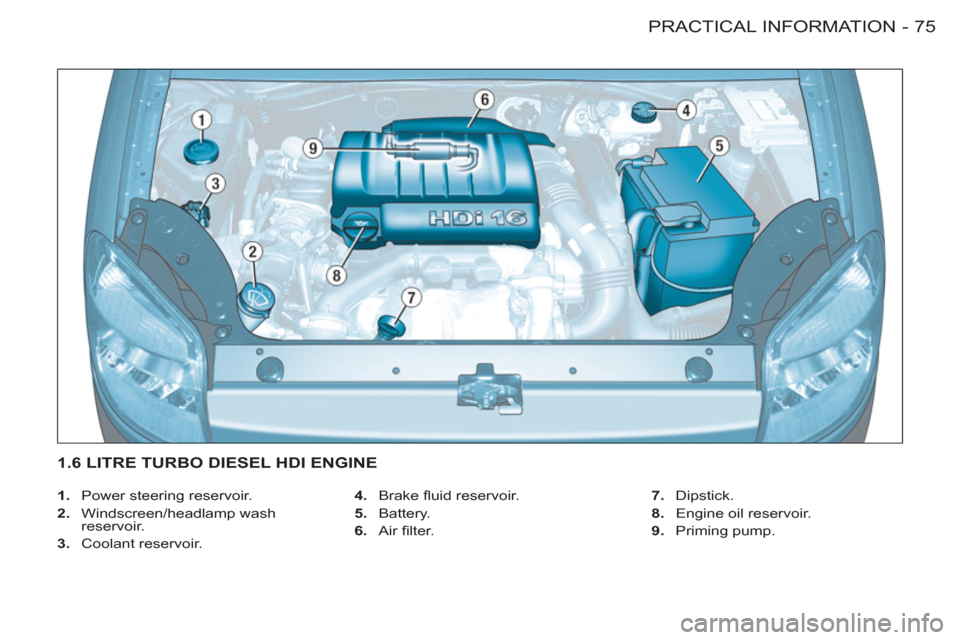
75 PRACTICAL INFORMATION
-
1.
Power steering reservoir.
2.
Windscreen/headlamp wash
reservoir.
3.
Coolant reservoir.
4.
Brake fl uid reservoir.
5.
Battery.
6.
Air fi lter.
7.
Dipstick.
8.
Engine oil reservoir.
9.
Priming pump.
1.6 LITRE TURBO DIESEL HDI ENGINE
Page 78 of 136
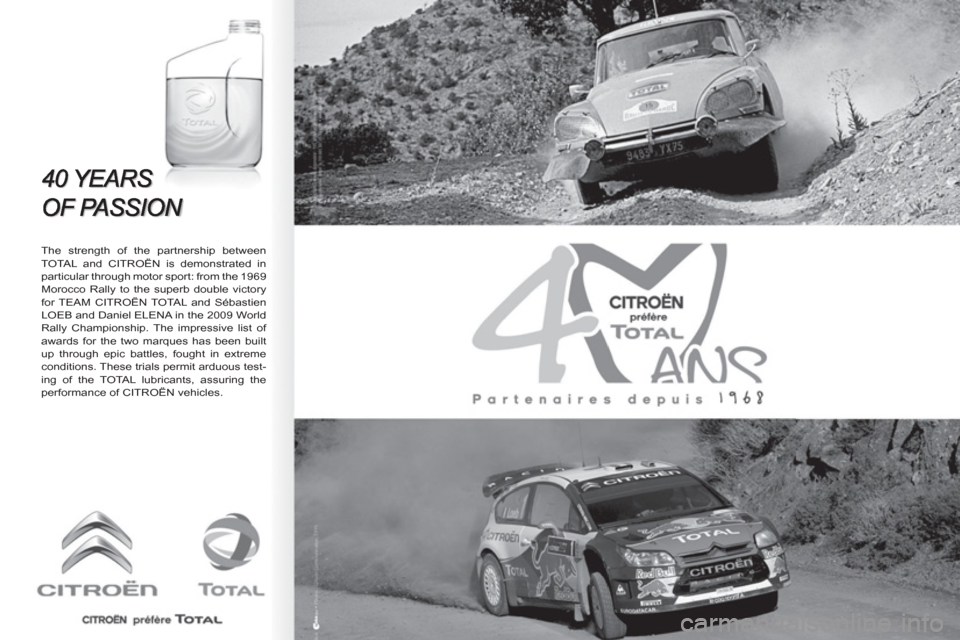
The strength of the partnership between
TOTAL and CITROËN is demonstrated in
particular through motor sport: from the 1969
Morocco Rally to the superb double victory
for TEAM CITROËN TOTAL and Sébastien
LOEB and Daniel ELENA in the 2009 World
Rally Championship. The impressive list of
awards for the two marques has been built
up through epic battles, fought in extreme
conditions. These trials permit arduous test-
ing of the TOTAL lubricants, assuring the
performance of CITROËN vehicles.
Page 79 of 136
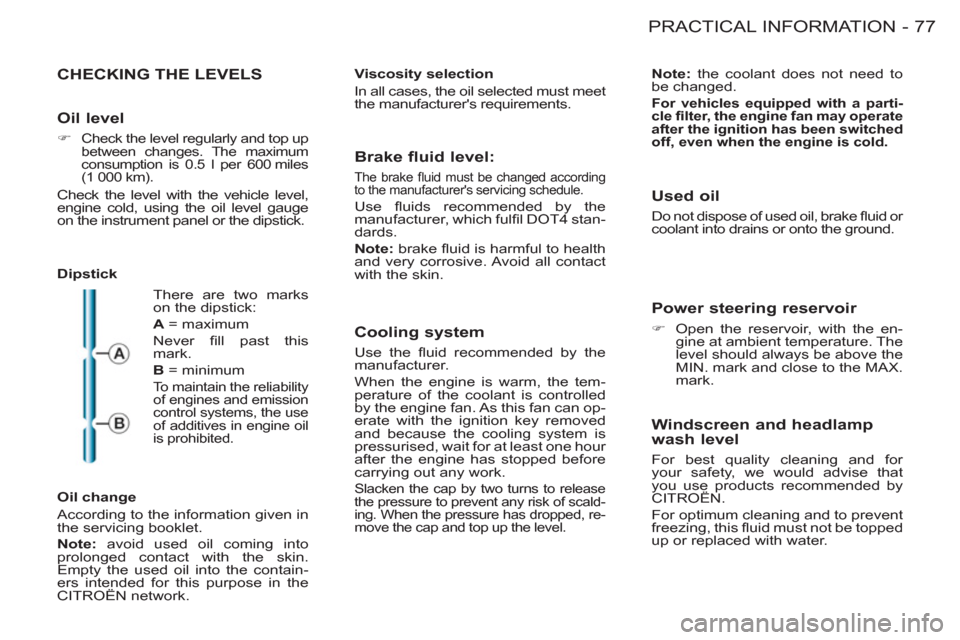
77 PRACTICAL INFORMATION
-
CHECKING THE LEVELS
Dipstick
Oil change
According to the information given in
the servicing booklet.
Note:
avoid used oil coming into
prolonged contact with the skin.
Empty the used oil into the contain-
ers intended for this purpose in the
CITROËN network.
Viscosity selection
In all cases, the oil selected must meet
the manufacturer's requirements.
Note:
the coolant does not need to
be changed.
For vehicles equipped with a parti-
cle fi lter, the engine fan may operate
after the ignition has been switched
off, even when the engine is cold.
There are two marks
on the dipstick:
A
= maximum
Never fi ll past this
mark.
B
= minimum
To maintain the reliability
of engines and emission
control systems, the use
of additives in engine oil
is prohibited.
Brake fluid level:
The brake fl uid must be changed according
to the manufacturer's servicing schedule.
Use fl uids recommended by the
manufacturer, which fulfi l DOT4 stan-
dards.
Note:
brake fl uid is harmful to health
and very corrosive. Avoid all contact
with the skin.
Cooling system
Use the fl uid recommended by the
manufacturer.
When the engine is warm, the tem-
perature of the coolant is controlled
by the engine fan. As this fan can op-
erate with the ignition key removed
and because the cooling system is
pressurised, wait for at least one hour
after the engine has stopped before
carrying out any work.
Slacken the cap by two turns to release
the pressure to prevent any risk of scald-
ing. When the pressure has dropped, re-
move the cap and top up the level.
Used oil
Do not dispose of used oil, brake fl uid or
coolant into drains or onto the ground.
Power steering reservoir
�)
Open the reservoir, with the en-
gine at ambient temperature. The
level should always be above the
MIN. mark and close to the MAX.
mark.
Windscreen and headlamp
wash level
For best quality cleaning and for
your safety, we would advise that
you use products recommended by
CITROËN.
For optimum cleaning and to prevent
freezing, this fl uid must not be topped
up or replaced with water.
Oil level
�)
Check the level regularly and top up
between changes. The maximum
consumption is 0.5 l per 600 miles
(1 000 km).
Check the level with the vehicle level,
engine cold, using the oil level gauge
on the instrument panel or the dipstick.
Page 80 of 136
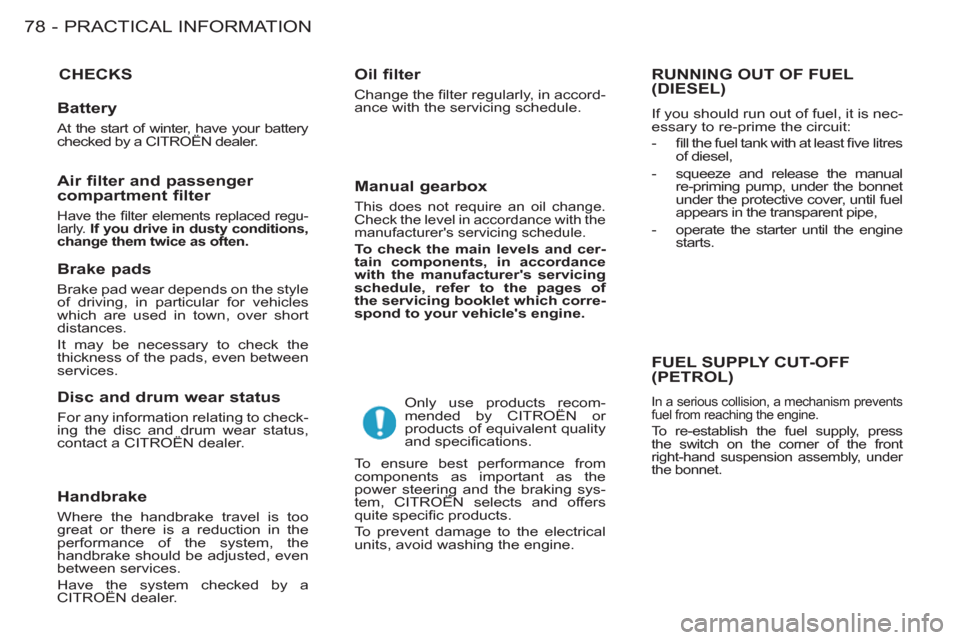
PRACTICAL INFORMATION
78 -
CHECKS
Oil filter
Change the fi lter regularly, in accord-
ance with the servicing schedule.
Only use products recom-
mended by CITROËN or
products of equivalent quality
and specifi cations.
To ensure best performance from
components as important as the
power steering and the braking sys-
tem, CITROËN selects and offers
quite specifi c products.
To prevent damage to the electrical
units, avoid washing the engine.
RUNNING OUT OF FUEL (DIESEL)
If you should run out of fuel, it is nec-
essary to re-prime the circuit:
- fi ll the fuel tank with at least fi ve litres
of diesel,
- squeeze and release the manual
re-priming pump, under the bonnet
under the protective cover, until fuel
appears in the transparent pipe,
- operate the starter until the engine
starts.
FUEL SUPPLY CUT-OFF(PETROL)
In a serious collision, a mechanism prevents
fuel from reaching the engine.
To re-establish the fuel supply, press
the switch on the corner of the front
right-hand suspension assembly, under
the bonnet.
Air filter and passenger
compartment filter
Have the fi lter elements replaced regu-
larly. If you drive in dusty conditions,
change them twice as often.
Brake pads
Brake pad wear depends on the style
of driving, in particular for vehicles
which are used in town, over short
distances.
It may be necessary to check the
thickness of the pads, even between
services.
Disc and drum wear status
For any information relating to check-
ing the disc and drum wear status,
contact a CITROËN dealer.
Manual gearbox
This does not require an oil change.
Check the level in accordance with the
manufacturer's servicing schedule.
To check the main levels and cer-
tain components, in accordance
with the manufacturer's servicing
schedule, refer to the pages of
the servicing booklet which corre-
spond to your vehicle's engine.
Handbrake
Where the handbrake travel is too
great or there is a reduction in the
performance of the system, the
handbrake should be adjusted, even
between services.
Have the system checked by a
CITROËN dealer.
Battery
At the start of winter, have your battery
checked by a CITROËN dealer.